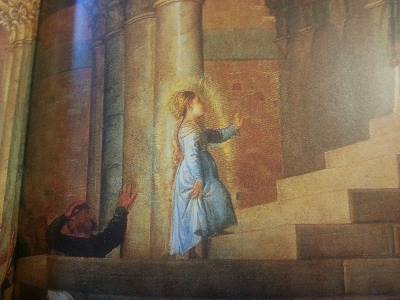 |
| Presentation of Mary by Titian |
Father Mark offers some history and thoughts to ponder on the feast commemorating Our Lady being taken to the Temple at the age of three by her parents.
In the hidden recesses of the old Temple, the Holy Ghost prepares the
new Temple, the all-holy Virgin, to become the Mother of God . Destined
to be the living Temple of the Word, Mary dwells in the Temple of the
Old Dispensation. She hears the chanting of the psalms, the prophets,
and the Law. Was it there that the Most Holy Virgin learned Psalm 118,
the long litany of loving surrender to the Word? And was it from Psalm
118, held in her heart from so tender an age, that she drew her response
to the message of the Angel, “Be it done unto me according to Thy Word”
(Luke 1:38)?
There planted in the Lord, the dew of His Spirit made her
flourish in the courts of her God, and like a green olive she became a
tree, so that all the doves of grace came and lodged in her branches.
(Saint John Damascene, Upon the Orthodox Faith, Book IV, ch. 15)
Virgin Mother of the Lamb
There Mary smells the fragrance of incense and burnt offerings. There
she observes the faithful of Israel streaming towards Zion, filling the
Temple, seeking the Face of the Lord. Priest, altar, and oblation are
not unfamiliar to the Virgin who, gazing upon her Son, will recognize in
Him the Eternal priest, the Altar of the New Covenant, the pure Victim,
the holy Victim, the spotless Victim offered in unending sacrifice.
To Belong to God
In the seventeenth century — the age of France’s “mystical invasion”
— the mystery of the Presentation of the Virgin in the Temple
captivated the hearts of Monsieur Olier and of others on fire with zeal
for the holiness of the priesthood, for the beauty of the consecrated
life, and for the worthy praise of God. The so-called French School of
spirituality, marked above all by the imperative of adoration and the virtue of religion,
gravitated to the feast of November 21st as to the purest liturgical
expression of the desire to be offered to God, to belong to God, and to
abide in God’s house.
Virgo Sacerdos
When, in 1641, Jean-Jacques Olier (1608 – 1657) established the
seminary of Saint-Sulpice, he placed it under the patronage of the
Virgin Mary in the mystery of her Presentation in the Temple. The Child
Mary, hidden in the Temple, learns the meaning of sacrifice and
oblation; she is the sacerdotal Virgin, prepared by the Holy
Spirit to stand at the altar of the Cross united to her Son, High Priest
and immolated Lamb. Under the influence of the French Sulpicians, many
religious congregations, established after the horrors of the French
revolution, chose the feast of the Presentation of the Virgin Mary as
their foundation day, the day of religious profession, and of the
renewal of vows. (Read more.)
This feast is a wonderful prelude to Advent. According to Dom
Gueranger:
Mary, led to the Temple in order to prepare in retirement, humility, and love for her incomparable destiny, had also the mission of perfecting at the foot of the figurative altar the prayer of the human race, of itself ineffectual to draw down the savior from heaven. (From Abbot Gueranger's The Liturgical Year, Vol XV )
 |
| "For better is one day in thy courts above thousands. I have chosen to be an abject in the house of my God, rather than to dwell in the tabernacles of sinners." Psalm 83:11 (The Vulgate) |




















2 comments:
I am having so much pleasure online today at rediscovering the many wonderful eikonographic depictions of this apocryphal tale - I like to establish credit for the creative efforts where I can on Twitter, and indicate the mystagogia-teaching enclosed within the tender docile images, here for example how the three steps echo the three aspects of the Trinitarian gift of faith you draw attention to in your post!
FYI there's an Ecuadorean image named Our Lady of the Ladder
commons*wikimedia*org/wiki/File:Virgen_de_la_Escalera_-_Fray_Pedro_Bed%C3%B3n_%28siglo_XVI%29.jpg more translate*google*com/translate?sl=es&tl=en&js=n&prev=_t&hl=en&ie=UTF-8&eotf=1&u=http%3A%2F%2Fwww*cervantesvirtual*com%2Fobra-visor%2Fcontribuciones-a-la-historia-del-arte-en-el-ecuador-volumen-iii--0%2Fhtml%2F00207432-82b2-11df-acc7-002185ce6064_23*html
as in the 'stairway to heaven' prefigured in supplanter/overreacher/defrauder Jacob's luminous vision of the ascending/descending angelic hosts of Heaven, prior to his renewal as Isra-el 'he who struggled with God') that visually mirrors the sentiment of the Church Father from Damascus
"and like a green olive she became a tree" with all her blessed Hebrew forefathers (so key in Spanish history of somewhat-forced evangelization of morisco converts, and perhaps therefore attraction to Mozarabic/Eastern-imagination iconography, nb in Arabic fatima means 'without fault/vice' ie the flawless one or immaculata, as 'fatwa' is teaching on avoiding faults, ie a lost Christian synthesis of faith and reason, training in virtue ever-dependent on the Divine Will) calling to mind the 'radix jesse' images of Advent antiphons
Fascinating! Thank you, Clare!
Post a Comment